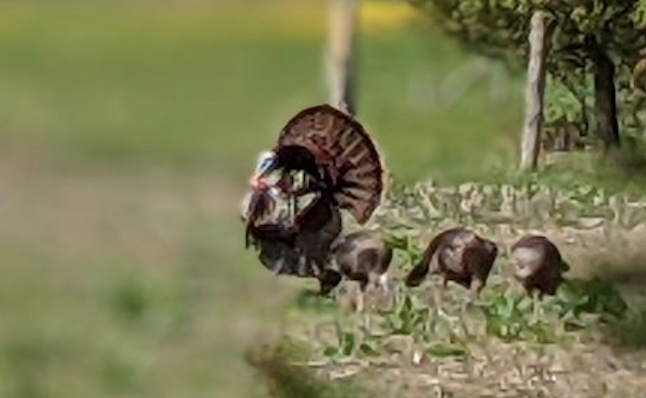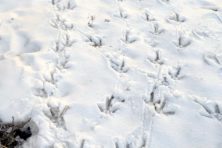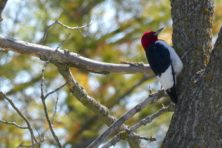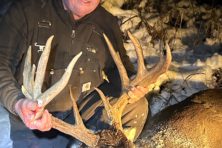Wild Things: Landowners Key to Hunting Success
- Share
- Tweet
- Pin
- Share

Access to private property fuels spring turkey tales
by KEVIN NAZE, [email protected], Peninsula Pulse contributor
When it comes to hunting success, there’s no bigger factor than location. And when it comes to abundant populations of wild turkeys, there’s no place like private farmland.
Fortunately, many farmers recognize that wild turkeys – like sandhill cranes – love to scratch up and eat freshly planted corn and other crops. The fact that most hunters aren’t going deep into deer-bedding areas also tends to make getting permission to hunt turkeys much easier than getting permission to hunt deer.
Still, not everyone is so fortunate: One of the toughest challenges for newcomers to the sport is simply finding a decent place to set up. That’s why hunters who have longtime friendships with landowners surely must recognize the blessing that access to prime private property provides.
A bird I harvested on a small piece of farmland recently is destined for the Crock-Pot with cream of chicken soup and rice. Some will be delivered to the landowner, who has never tried wild turkey.
Within hours of tagging the tom, I took the neighbor pasture-raised eggs from another farmer friend, wild asparagus picked minutes earlier, and a freshly caught, filleted rainbow trout marinated in lemon and lime juice and coated in lemon pepper and Cajun breading.
It was a small, but welcomed gesture: a thank-you for the gift of being able to hunt.
For those who don’t own or lease private land, maintaining good relationships with landowners who allow access is crucial. Whether fostering those relationships comes in the form of helping around the farm, cleaning up litter or giving gifts from time to time, such offerings go a long way toward keeping the door open to you and others.
Reel Impressive
Fishing guides Brett Alexander and Eric Haataja averaged an impressive 5.8 pounds per bass in winning the 82-team Adrians Memorial Team Open last weekend. It was part of the Wisco Bass Anglers Series and headquartered at Little Sturgeon Bay.
During the tourney, 693 fish were caught, weighed on shore and released back into the bay. The average size was a hefty 4.55 pounds – an average helped by 14 that weighed more than six pounds and two that were seven-plus. Alexander and Haataja caught one of the latter: a 7.42-pounder that was easily the biggest of the weekend.
Tournament pro Adam Neu of Howie’s Tackle and his teammate, Jimmy Doering, were second with 54.11 pounds. You can see the complete results at wiscobass.com/boat-numbers.
This competing event reduced participation in the Sturgeon Bay Bass Tournament (SBBT) to 17 teams, but thanks to generous sponsors, the SBBT was able to pay 250% of the registration fee back to winning teams, including $6,000 for first place, $4,500 for second and $2,100 for third. Every team got in on the money.
Gordon and Easton Fothergill of Grand Rapids, Minnesota, won the SBBT with 53.50 pounds on the allowed 10 fish over two days, including a 6.36-pounder.
Five youth teams took part, including Scott and Calvin Richards of Sturgeon Bay, who were second overall with 50.28 pounds. Placing third was the Sturgeon Bay team of John Kolodziej and Jonathon Meacham with 48 pounds – just six-hundredths of a pound ahead of Travis Stangel and Rod Hedsand.
One of the youth teams, Jordan and Kenton Koblica, had the tournament’s heaviest catch at 6.50 pounds.
Nine teams were from Sturgeon Bay, and others were from the greater Green Bay area, Sussex, Illinois and Michigan.
Next up, the 33rd Sturgeon Bay Open Bass Tournament will run May 19-20 at Sawyer Park. Follow along at northamericanbasschallenge.com/sturgeon-bay-open-bass-tournaments.
The Survey Says…?
Jeff Pritzl, deer program specialist for the Wisconsin Department of Natural Resources (DNR), said the final report is not out yet, but he provided County Deer Advisory Council members with a few nuggets of information from the DNR’s random postseason mail survey of thousands of deer hunters. Although only a small percentage of hunters take part in the survey, it does provide some information on trends at the statewide and management-zone levels.
Pritzl said the results – extrapolated out after considering the total number of hunting licenses purchased – estimate that deer hunters spent about 5.1 million days in the farmland zones and 1.8 million days in the forest zones. The total number of days hunted dropped about 5% from 2021, yet the harvest was up.
The estimates include 2.4 million days spent during the nine-day gun season (five days per average hunter), 2.1 million days spent bow hunting (16 days per average hunter), and 2 million days spent crossbow hunting (13.8 days per average hunter).
The DNR estimates that about 26,000 youth participated in the youth hunt, about 32,000 hunters in the holiday gun hunt, and about 63,000 hunters in the muzzleloader and four-day December antlerless hunt.
You can check out past reports on deer and other huntable game species at dnr.wisconsin.gov/topic/WildlifeHabitat/reports.html.
Natural Resources Board Meeting Set for May 24
The agenda for the state Natural Resources Board meeting May 24, 8:30 am, includes a summary of the Wisconsin Conservation Congress’ spring hearing advisory question and Bureau of Fisheries and Wildlife Management’s spring fish and wildlife votes, an update on Wisconsin’s elk herd, and results of chronic wasting disease (CWD) surveillance. More than 200 deer tested for CWD in Door and Kewaunee counties in recent years have all been negative.
Tune in to the meeting at youtube.com/live/78WkA_VUVtI?feature=share.



